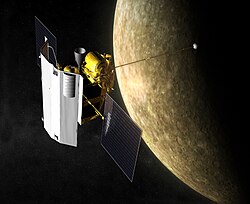MESSENGER
MESSENGER, MErcury Surface, Space ENvironment, GEochemistry and Ranging, was an unmanned NASA and APL spacecraft.[7] It was orbiting and studying the planet Mercury.[7] Its mission lasted 10 years, 8 months and 28 days.
 Artist's rendering of MESSENGER orbiting Mercury. | |
| Mission type | Mercury probe |
|---|---|
| Operator | NASA |
| COSPAR ID | 2004-030A |
| SATCAT no. | 28391 |
| Website | messenger |
| Mission duration | Total: 10 years, 8 months and 27 days At Mercury: 4 years, 1 month and 14 days En route: 7 years Primary mission: 1 year First extension: 1 year[1] Second extension: 2 years[2][3] |
| Spacecraft properties | |
| Manufacturer | Applied Physics Laboratory |
| Launch mass | 1,107.9 kg (2,443 lb) |
| Power | 450 watts |
| Start of mission | |
| Launch date | August 3, 2004, 06:15:56 UTC |
| Rocket | Delta II 7925H-9.5 |
| Launch site | Cape Canaveral SLC-17B |
| Entered service | April 4, 2011 |
| End of mission | |
| Disposal | Deorbited |
| Destroyed | April 30, 2015 at 19:26 UT[4] |
| Orbital parameters | |
| Reference system | Hermiocentric |
| Perihermion | 200 kilometers (120 mi) |
| Apohermion | 10,300 kilometers (6,400 mi) |
| Inclination | 80 degrees |
| Period | 12 hours |
| Epoch | Jan 1, 2000[5] |
| Flyby of Earth (gravity assist) | |
| Closest approach | August 2, 2005 |
| Distance | 2,347 kilometers (1,458 mi) |
| Flyby of Venus (gravity assist) | |
| Closest approach | October 24, 2006 |
| Distance | 2,990 kilometers (1,860 mi) |
| Flyby of Venus (gravity assist) | |
| Closest approach | June 5, 2007 |
| Distance | 337 kilometers (209 mi) |
| Flyby of Mercury | |
| Closest approach | January 14, 2008 |
| Distance | 200 kilometers (120 mi) |
| Flyby of Mercury | |
| Closest approach | October 6, 2008 |
| Distance | 200 kilometers (120 mi) |
| Flyby of Mercury | |
| Closest approach | September 29, 2009 |
| Distance | 228 kilometers (142 mi) |
| Mercury orbiter | |
| Orbital insertion | March 18, 2011, 01:00 UTC[6] |

| |
It was launched on August 3, 2004[7][8] at Cape Canaveral Air Force Station. It was aboard a Boeing Delta II rocket.[8] After launch, the probe did several fly-bys and deep space manoeuvres to gain the right trajectory and speed.[7]
It completed 30% mapping of Mercury on January 14, 2008. MESSENGER made one more pass by Mercury in 2009, and on March 18, 2011 began to orbit Mercury.[7][9] 100% mapping was completed in March 2013 and the probe continued its studies. On April 30, 2015, it crashed into Mercury. It crashed near the crater Janáček.
MESSENGER Media
"GRS measures gamma rays emitted by the nuclei of atoms on Mercury’s surface that are struck by cosmic rays. Each element has a signature emission, and the instrument will look for geologically important elements such as hydrogen, magnesium, silicon, oxygen, iron, titanium, sodium, and calcium. It may also detect naturally radioactive elements such as potassium, thorium, and uranium. "
References
- ↑ "NASA extends spacecraft's Mercury mission". UPI. November 15, 2011. Retrieved December 20, 2012.
- ↑ Wu, Brian (April 3, 2015). "NASA Set to Extend Mercury Mission for Another Month". Johns Hopkins University APL (The Science Times). http://www.sciencetimes.com/articles/5077/20150330/nasa-set-extend-mercury-mission-another-month.htm. Retrieved April 4, 2015.
- ↑ "MESSENGER's Operations at Mercury Extended". Johns Hopkins University APL (SpaceRef.com). April 3, 2015. http://spaceref.com/mercury/messengers-operations-at-mercury-extended.html. Retrieved April 4, 2015.[dead link]
- ↑ "Beyond Earth: A Chronicle of Deep Space Exploration".
- ↑ Domingue, D.L.; Russell, C.T. (2007). Messenger mission to Mercury (1st ed.). New York: Springer. pp. 225–245. ISBN 9780387772141.
- ↑ Lee, Jimmy; Galuska, Mike (March 18, 2011). "NASA Chats – MESSENGER Prepares to Orbit Mercury". NASA. Archived from the original on June 7, 2011. Retrieved March 18, 2011.
- ↑ 7.0 7.1 7.2 7.3 7.4 How it works book of amazing technology : everything you need to know about the world's best tech. Bournemouth: Imagine Pub. 2011. pp. 48–49. ISBN 978-1-908222-08-4. OCLC 784550467.
- ↑ 8.0 8.1 "Launch Coverage: MESSENGER Mission". NASA. Archived from the original on 2011-08-04. Retrieved 2011-07-30.
- ↑ Murchie, Scott L.; Vervack Jr., Ronald J.; Anderson, Brian J. (March 2011), "Journey to the Innermost Planet", Scientific American, New York, vol. 304, no. 3, pp. 26–31, Bibcode:2011SciAm.304c..34M, doi:10.1038/scientificamerican0311-34, PMID 21438487

